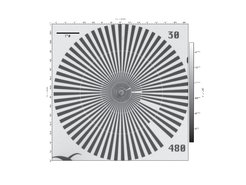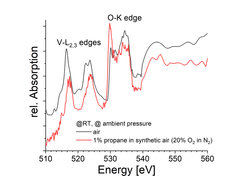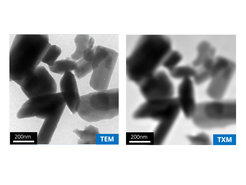MYSTIIC: New X-ray microscope at BESSY II

The Energy Materials in situ Lab (EMIL) is directly connected to two beamlines at BESSY II, which provide intense synchrotron radiation for research. One beamline provides hard X-rays, the other soft X-rays for the experiments at EMIL. EMIL is operated jointly by HZB and the Max Planck Society (MPG). Now, an HZB team has set up a new scanning transmission X-ray microscope (STXM) at the soft X-ray beamline in the BESSY II experimental hall. It was named MYSTIIC - Microscope for x-raY Scanning Transmission In-situ Imaging of Catalysts.
Compared to other X-ray microscopes, the STXM MYSTIIC at EMIL offers even higher precision and more options for scanning surfaces and investigating bulk samples in transmission. In particular, MYSTIIC will also allow to observe chemical processes in gas/liquid cells in the future. "It is like filming the processes taking place during catalysis," says HZB expert Dr Markus Weigand, who is in charge of the instrument. The implementation of a gas mixing system, which is being developed together with the AC department of the Fritz Haber Institute (FHI) of the Max Planck Society, is currently in progress in order to analyse how different gases (for example CO2, CH4, H2 etc.) chemically change the surface of a catalyst on the nanoscale. The new microscope will thus contribute significantly to CatLab's approach on knowledge and understanding in order to develop novel catalyst.

"Initially, we want to test the instrument with HZB teams or users we know (friendly users)," explains Weigand. For example, HZB researcher Dr Tristan Petit will be the first to investigate so-called MXenes with MYSTIIC. MXenes can absorb and store large amounts of electrical energy very fast. "We want to scan the surfaces of MXene particles with MYSTIIC and find out which elements are involved in certain chemical processes. This will help us to better understand the amazing properties of this class of materials," Petit explains. He and his team are currently preparing the installation of special sample cells for investigations on catalysis, electrochemistry and electrocatalysis. Sample heating up to 1000 °C is also planned. In the future, routines will be developed in collaboration with the FHI that will make it possible to use the same cells for electron microscopy studies in order to combine energy and spatial resolution on the same sample.

The instrument is designed with upgrades to expand capabilities in mind, which will include advanced operando cells and x-ray cameras systems to enable resolving structures of even a few nanometres using ptychographic methods.
Up to now, there have been two X-ray microscopes at BESSY II with very different purposes. Another STXM (MAXYMUS), operated by MPI-IS, focuses on magnetism and time resolution. Nanoscale NEXAFS spectromicroscopy of energy materials (see examples below) and tomography – for example of shock frozen cells - in the soft and tender X-ray regime can be examined in Prof. Dr. Gerd Schneider's group. MYSTIIC at EMIL is particularly suitable for resolving questions related to energy materials research and environmental sciences.
External users are invited to apply for beam time at MYSTIIC at EMIL from the first call for 2022.














